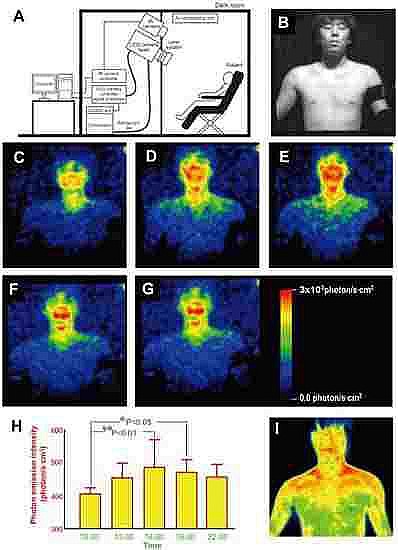Fact-Check: Human Body Emits Visible Light
♦ 20 Amazing Facts About The Human Body
♦ How Much Is Your Body Worth on The Black Organ Market?
 |
| The body emits visible light: An aura is a colorful halo that surrounds the body of a person or object, representing a particular energy state. |
People and objects with halos appeared in ancient paintings. Saints are depicted with shining auras on their heads in Christianity, Buddhism, and other religions. The Holy Trinity shines with light, as do the bodhisattvas and the great monks who have cultivated for a long time.
All people and things have the ability to emit aura
Parapsychologists now believe that all people and objects can emit auras. It is a colorful halo that surrounds a person or object's body and represents a specific energy state. This phenomenon can be seen with the naked eye with practice, but vision deteriorates with age.
The aura is divided into Spirit Light, Right Light, and seven different energy levels. The aura is multicolored. It is black or crimson when angry. The monk has an orange aura around him. The color and intensity of the aura are linked to one's health.
Plants, according to parapsychologists, emit auras in the form of energy fields, which can be strong or weak depending on their tolerance. Wild plants and trees, for example, have a stronger aura than indoor flowers because they are more vibrant.
| Previous studies have found that the human body emits visible light, but 1000 times weaker than the intensity of light that we see with the naked eye, all animals can also emit light. very weak light. It is thought to be the result of free radicals involved in biological chemical reactions. Visible light is not the same as infrared, because infrared is not visible light. |
Halo Camera
Parapsychologists believe that the universe and the world contain a variety of energy fields. Meanwhile, humans will be limited by five common senses in the absence of science and technology.
As a result, many phenomena exist that we are unaware of, such as cosmic radiation, electromagnetic radiation from the earth's field, and man-made radiation such as lasers. As a result, it is natural for people to fail to recognize the aura of all things.
The Kirlian Effect was named after a Russian electrical engineer who accidentally discovered it in 1939. He works as an electrician in a hospital. Kirlian was discharged but unharmed once while repairing a high-frequency generator.
He attempted to image an object in a high-voltage electric field and obtained a film image of the object with a surrounding halo. Depending on the type of matter, that halo has different properties.
When the hospital got a new generator, Kirlian was allowed to experiment with the old one. He aimed to capture various types of matter and make their aura images more clear and systematic.
His and his colleagues' research has piqued the state's interest. In 1950, he received funding to construct a more modern laboratory. Kirlian's research findings have piqued the interest of both domestic and international scientists.
Along with Kirlian, Georges Hadjo (UK) invented the bio-halo scanner in 1970. He is a photographer, and instead of attaching one electrode to the film as Kirlian suggests, he attached many different electrodes to various parts of the body and took auras of the majority of them.
Natural scientists have also explained the phenomenon of aura photographs of people, animals, plants, and objects captured using various shooting techniques. They believe that when a substance is placed in a high-voltage electric field, the phenomenon of electric field absorption and scattering on the matter's surface will occur. This causes a change in the electric field value (much like when light hits an object and is absorbed and scattered).
The image of the electric field captured on film simply reflects that phenomenon; it does not imply that matter emits an aura. Natural scientists, on the other hand, have not been able to confirm whether or not matter emits special bioenergy fields.
Meanwhile, supporters of the "halo" school of thought have continued to develop new generations of halo scanners, even selling them to the general public. They collected images of the aura in a systematic manner and related them to medical and psychological applications.
It is also the foundation for the development of medical examination through aura imaging, which uses the distribution of "energy" on images to assess health status. Intoxicated patients have a split energy rim that shows deterioration, whereas cancer patients have a coal black energy rim. The aura image on the ring finger will be confused, scattered, blurred, and red in patients with autism, stress, or psychological trauma.
Scientists, on the other hand, claim that there is no evidence to support the effectiveness of medical examination and treatment based on the Kirlian effect. Decoding the human aura has been going on for thousands of years and is still going on.
Interesting Facts About the Human Body Emits Light
 |
| The intensity of light emitted from the body fluctuates up and down, the light intensity is weakest at 10 am, and strongest at 4 pm, then gradually becomes weaker. |
Japanese scientists confirmed that the human body emits weak visible light. This light increases and decreases with each time of the day.
Kyoto University (Japan) scientists use special cameras capable of detecting individual photons (photons) to better understand the light emitted by the human body. In a cramped and dark room, five young volunteers in their twenties were asked to go topless and sit in front of cameras. For three days, they sat in the same room from 10 a.m. to 10 p.m.
The cameras captured images of countless photons emitted from the bodies of five volunteers. The number of photons gradually increases and decreases, reaching a minimum at 10 a.m. and a maximum at 4 p.m. This demonstrates that the level of light radiation in the body is affected by the circadian cycle, as human metabolism varies with the time of day.
In comparison to the rest of the body, the face emits the most light. According to the researchers, this occurs because the face is the darkest part (it receives the most sunlight). Melanin, the pigment that gives skin color, contains luminescent components that can boost the intensity of light emitted by the body.
The scientists believe their cameras can detect the places that emit the fewest photons due to the faint light the body emits in relation to metabolism.
"You can diagnose a person's overall health by observing the weakest areas of the body." "This has significant medical implications," said Hitoshi Okamura, a biologist at Kyoto University.
 Fact-Check: Vanga Predicted the War Between Israel and Hamas? Fact-Check: Vanga Predicted the War Between Israel and Hamas? |
 Fact-Check: What Did Nostradamus Predict for the World in 2024 Fact-Check: What Did Nostradamus Predict for the World in 2024 |
 Interesting Facts About Landlocked Countries in The World Interesting Facts About Landlocked Countries in The World |























